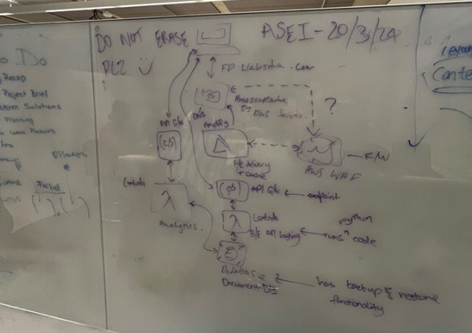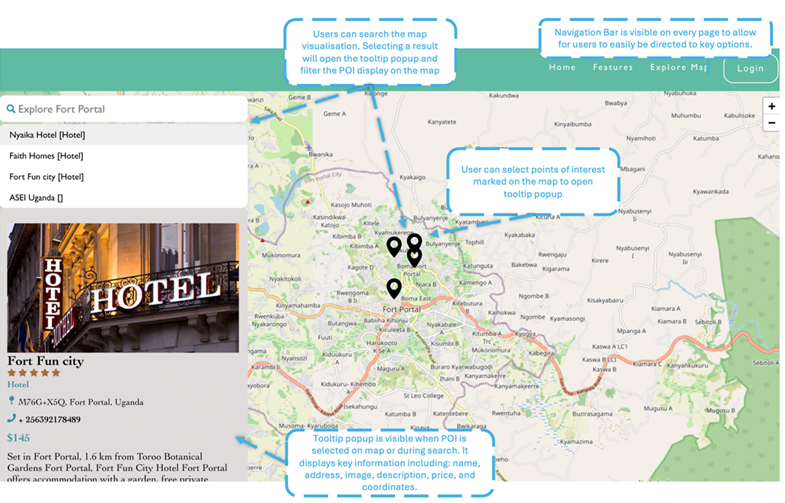Finding the best possible solution to a real-world problem can be challenging for young students with limited or no prior experience, even though industry bets on them for new ideas, approaches to problem solving and easily blending in into the world of work. How the companies define the challenges in question, how student teams are set up and the level of mentorship both from industry and academic supervisors are equally important in ensuring that the best possible solutions are found.
In her own words, Alicia, a software engineering student at the University of Technology Sydney, shared her team’s experience with an industry project facilitated by indEx in partnership with ASEI Uganda. She talked about how they found out about the project, her motivation, teaming up with others, planning and implementing the project, the results, challenges faced, and lessons learned.
The Project, and Objectives
In our first semester of 2024, we participated in a subject that allowed us to work with external clients to develop our soft and technical skills. We had the pleasure of meeting and working with Moses and Andrew from ASEI Uganda to support their requirements.
We had two main objectives:
- Develop a mapping system prototype that will allow users to view key points of interest in the Fort Portal area
- Demonstrate the feasibility of capturing insights and data to drive key decisions

Our Team Photo
The Problem We Were Tackling
Projections indicate that half of Africa's population will migrate to urban areas by 2030; Uganda has taken steps to address urbanisation challenges by designating ten municipalities, including Fort Portal, as secondary cities. As part of Uganda’s 2040 Vision, Fort Portal is also set to become a tourism hub, showcasing natural wonders and cultural heritage.
Fort Portal has identified that there needs to be more comprehensive street mapping for navigation and tourism to support the burgeoning sectors. This project aimed to support Fort Portal’s digital transformation by developing an online mapping system to highlight key points of interest, enhance accessibility, and support sustainable tourism development. The final product will be a prototype aimed at building a foundation for future development.
Team Selection, Roles and Motivation
At the beginning of the semester, we were presented with various projects. I was particularly drawn to working with ASEI Uganda on the mapping solutions project because it offered a unique opportunity to support community development alongside diverse stakeholders.
We had an amazing team that included Imogen, our project lead; Amit, Alfred and myself as backend developers; Ma’en and Moses as front-end developers; Mark and Raymond as our business analysts; and Mohamad as our tester.
Our project team was formed based on shared interests and goals. We began by discussing our strengths and the objectives we wanted to achieve throughout the project. Each member chose a specific role aligned with their skills and aspirations.
- Leader: Responsible for coordinating the team's efforts, meeting milestones, and facilitating communication among all members.
- Back End Developer: Focused on server-side development, managing databases, and integrating APIs to ensure the functionality of the mapping system.
- Front End Developer: Worked on the user interface, ensuring the map was interactive, user-friendly, and visually appealing.
- Business Analyst: Conducted research to understand user needs, gathered requirements from stakeholders and ensured the solution aligned with ASEI Uganda and the Fort Portal communities’ objectives.
- Tester: Ensured the quality and reliability of the system by performing testing, identifying bugs, and verifying that all features worked as intended.
By maintaining clear communication, we contributed to Fort Portal’s digital development by building a foundation for a comprehensive mapping system.
Project Planning and Timeline
Our project followed a structured, agile process divided into four two-week sprints. This approach allowed us to meet milestones efficiently and adapt to feedback, ensuring a robust mapping solution for Fort Portal Tourism City.
- First Sprint: Focused on research and design, we initiated the database setup and backend development.
- Second Sprint: Built out the solution architecture, developed UI/UX designs and began prototyping.
- Third Sprint: Expanded available features and implemented data analytics.
- Fourth Sprint: Added administrative features and finalised documentation to ensure smooth project continuation post-handover.

Brainstorming Session
Solution and Implementation
While developing the mapping solution for Fort Portal, we adopted an agile approach, which facilitated continuous feedback from the team and iterative improvements. This methodology ensured our solution remained flexible and responsive to evolving requirements.
We leveraged open-source technologies throughout the project to ensure cost-effectiveness and scalability for the solution. Our prototype mapping solution utilised Leaflet and OpenStreetMap to create an interactive map highlighting key points of interest in the Fort Portal area.
For the backend, we chose FastAPI due to its high performance and ease of use, enabling us to build the system quickly and efficiently. This combination of tools and methodologies allowed us to deliver a robust and adaptable mapping solution to suit the community's needs.
Results and outcomes
By the end of the project, we successfully developed several key features, including a video landing page, an administrator login, interactive map features, a search bar, points of interest display, and a user demographics and analytics dashboard. These components will collectively enhance user experience, navigation, and data insights for Fort Portal's tourism initiatives.
We hope that our project can contribute to a functional and impactful solution for the Fort Portal Tourism City Community.

Challenges and Obstacles
Our team faced challenges due to the need to develop new skills to utilise new technologies and learn new processes, such as FastAPI, MongoDB, and agile development practices.
To overcome these obstacles:
- Collaborative Learning: We held regular sessions and workshops to learn from our peers and discuss our obstacles so that we could work together to overcome them.
- Mentorship: We got advice from our academic advisors and ASEI Uganda to understand the best practices for the team and for the project development.
- Online Resources: We used online tutorials and documentation to enhance our learning.
- Iterative Practice: We applied our new skills in each sprint, learning through hands-on experience and feedback.
These strategies helped us become proficient in new technologies. When our initial ideas encountered obstacles, we found alternative avenues to achieve our goals. This approach allowed us to be responsive to the changing technological landscape and the requirements of ASEI Uganda.
Lessons Learned and Takeaways
My biggest learning was embracing the idea that it's okay to experiment and encounter setbacks. During moments of challenge, where solutions took time, I found that I was learning the most. By seeking advice from peers and mentors and exploring alternative approaches, I was able to expand my understanding as a software engineering student.
I was incredibly fortunate to work with Moses and Andrew at ASEI Uganda, whose active involvement and support ensured our alignment with shared goals. Sometimes, immersing yourself in challenging situations is the most effective way to learn. This project provided invaluable hands-on experience in a real-world context. I would highly recommend getting involved in a project and particularly projects run by ASEI Uganda.
Final Remarks
Our team successfully developed a foundation for an online mapping system for Fort Portal, overcoming our initial skill gaps and learning new technologies such as FastAPI, MongoDB, and agile development practices. Through collaborative efforts, mentorship, and iterative practice, we created a solution that will contribute to supporting Fort Portal's digital transformation and tourism objectives.
This project significantly enhanced our technical skills, teamwork, and problem-solving abilities. Engaging in an industry project and with ASEI Uganda provided invaluable real-world experience and demonstrated the importance of adaptability and continuous learning. The importance of practical, hands-on projects in bridging the gap between academic knowledge and professional application is so valuable in preparing us for future careers in engineering and technology.
Acknowledgements
I’d like to say a special thank you to Moses and Andrew from ASEI Uganda for their commitment and support, which was instrumental in our development as young engineers in a professional environment. Their patience and understanding were invaluable as we developed throughout the project. I’d also like to say thank you to Eva and Matthew for their continued support and valuable insight throughout the semester.
The guidance and encouragement we received significantly contributed to the success of our project.